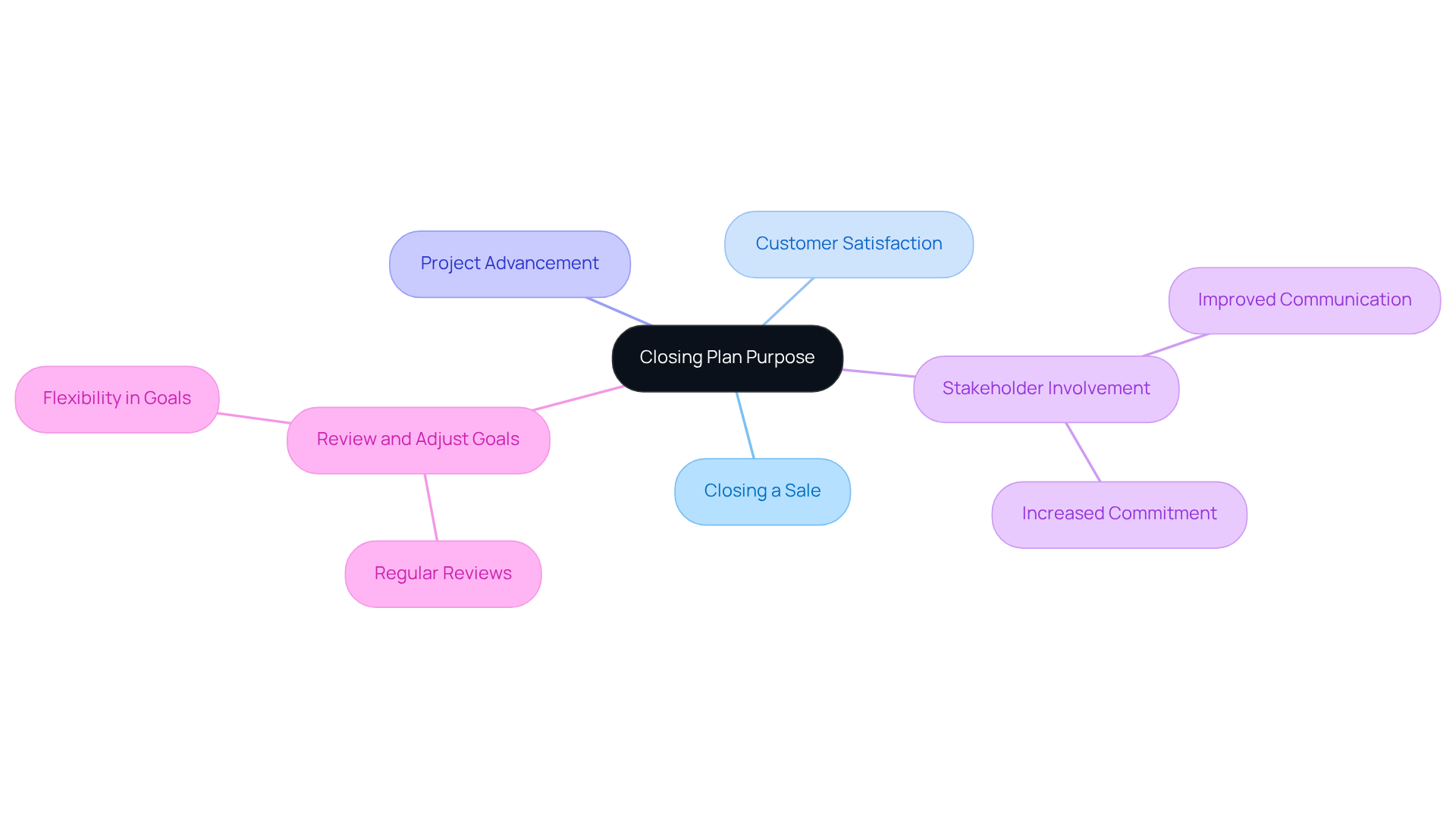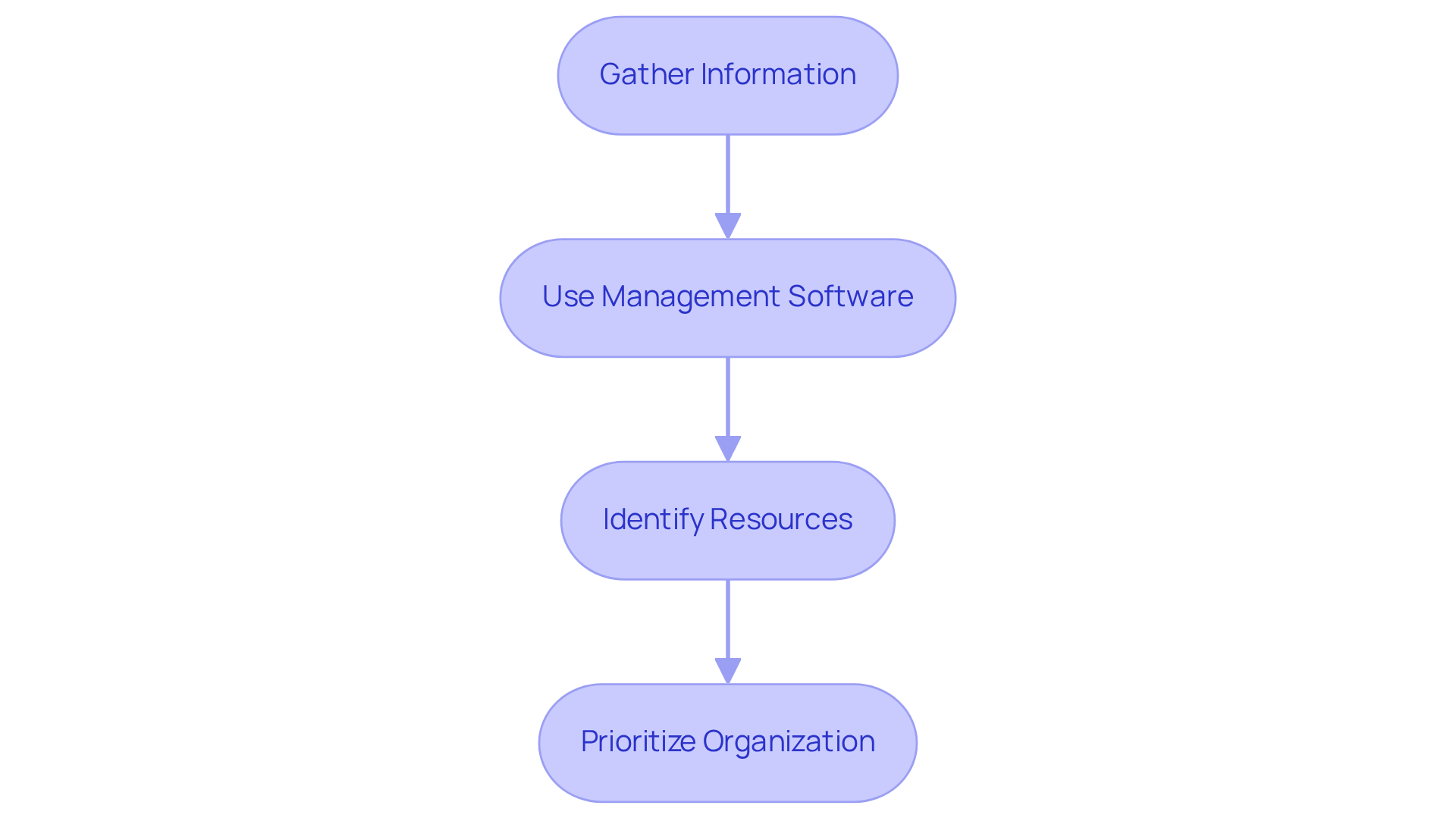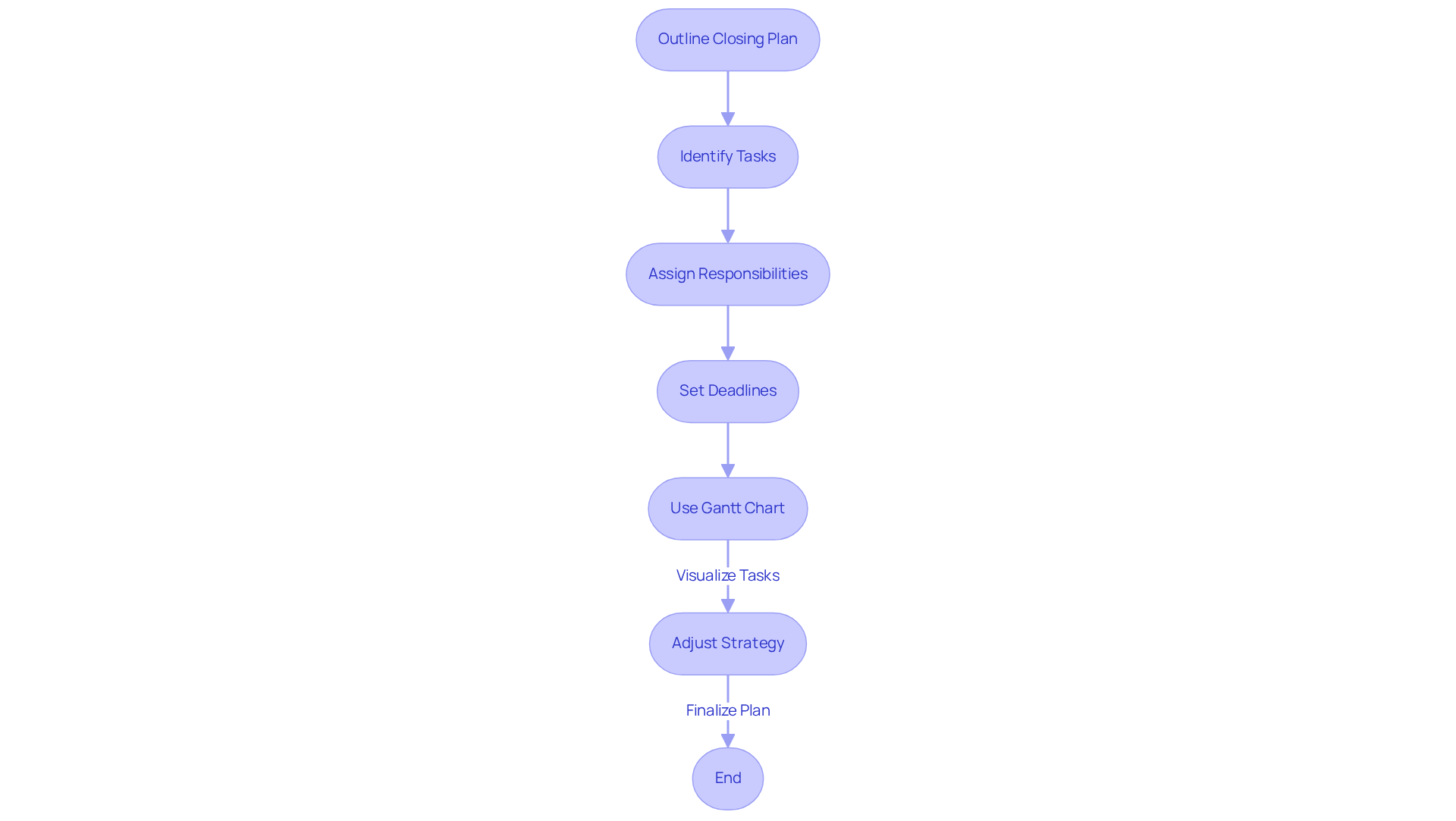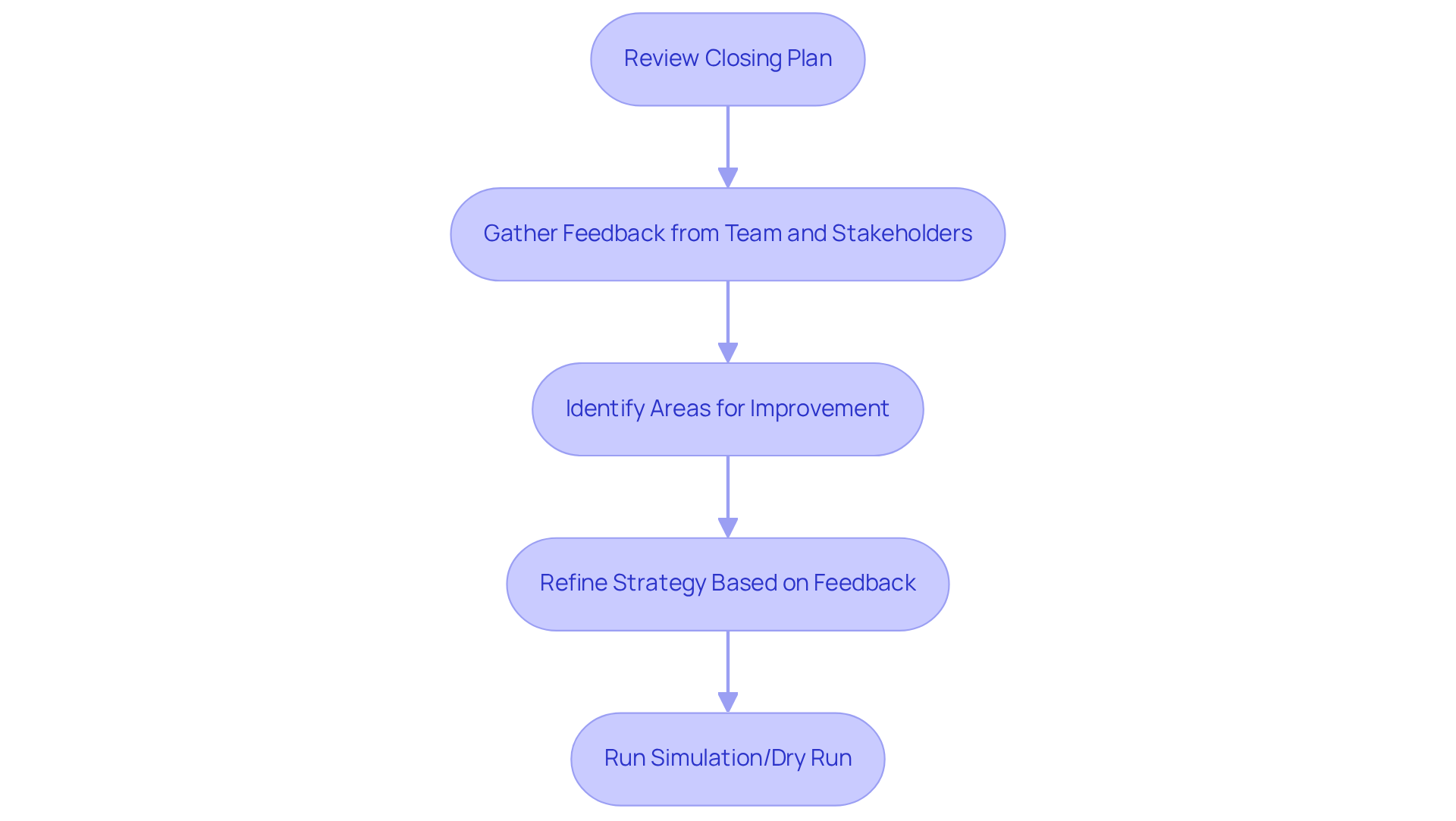
Overview
You might be wondering how to create an effective closing plan, right? Well, it all starts with defining clear objectives. From there, gather all the necessary information and resources you’ll need. Next, structure your plan with key milestones, and don’t forget to regularly review and refine your strategy!
Now, here’s the fun part: studies show that having written goals can really boost your success rates. Plus, when stakeholders are involved, it enhances their commitment to the project. And let’s be honest, using tools like Gantt charts and management software can make the planning process a breeze. This ultimately leads to a more successful closing outcome, and who doesn’t want that?
Key Highlights:
- Define clear objectives for your closing plan, which can include closing sales and ensuring customer satisfaction.
- Writing down goals increases the likelihood of achieving them by 42%.
- Involve key stakeholders to improve communication and commitment, as 80% of management respondents desire more involvement.
- Regularly review and adjust goals to keep them relevant and aligned with shifting priorities.
- Gather essential information such as customer details, timelines, and budget constraints to guide your closing efforts.
- Utilise management software and tools like SowFlow for efficient data organisation and documentation.
- Identify and ensure the availability of necessary resources to avoid performance waste, which can account for nearly 10% of expenditures.
- Outline the framework of your closing plan, identifying key milestones, tasks, responsibilities, and deadlines.
- Gantt charts are effective for visualising timelines and dependencies, with 67% of projects using them.
- Gather feedback from team members and stakeholders to refine the closing plan and identify potential issues.
- Conduct simulations or dry runs of the closing process to prepare for actual execution.
Introduction
Creating a successful closing plan is super important for any project, right? It doesn’t just mark the end of an initiative; it also makes sure that objectives are met and stakeholders are happy. You might be wondering how to go about it. Well, this guide lays out four key steps that will help you, as a project manager, craft a closing plan that’s both effective and adaptable.
But what happens when unexpected challenges pop up during those final stages? Let’s explore some strategies for:
- Defining goals
- Gathering resources
- Structuring your plan
- Refining it through feedback
By the end of this article, you’ll be equipped with the tools you need to navigate potential pitfalls and achieve a smooth project conclusion.
Define the Purpose of Your Closing Plan
To kick things off, let’s discuss the primary objectives of your closing plan. You might be asking yourself: What do you really want to achieve by the end of this journey? It could be , making sure your customer is happy, or taking your project to the next level. Make sure to jot these goals down—research shows that people who write down their objectives are 42% more likely to hit their targets. will guide your actions and decisions as you wrap things up.
Now, why not bring in some key stakeholders for a chat? Gathering , and you’ll find that nearly 80% of management survey respondents wish there was more in the development process. Involving these stakeholders doesn’t just improve communication; it also , leading to a more . Plus, organizations that set see significantly higher success rates. After all, a , affecting 37% of them.
It’s also a good idea to regularly review and tweak your goals. This way, you can ensure they stay relevant and in line with any shifting priorities. So, are you ready to dive in and begin ? Let’s make it happen!

Gather Necessary Information and Resources
You might be wondering where to start in order to create an effective closing plan. Begin by gathering all the . This includes customer details, timelines, budget constraints, and a record of past communications with stakeholders. Using management software can really simplify this process; did you know that rely on such tools to boost organization and efficiency? And don’t forget about spreadsheets—they can be a lifesaver for systematic data management.
Now, let’s talk about . With it, you can easily craft to all the documentation your team needs. This means and the ability to quickly update your documents, .
Next up, identify the resources you’ll need for your closing plan. Think about team members, necessary tools, and any external support. It’s crucial to ensure these resources are readily available—after all, nearly 10% of every dollar is wasted due to poor performance, often because of inadequate planning and resource distribution. By prioritizing , and using [SowFlow](https://sowflow.io)'s , you’re setting yourself up for a successful completion.

Create the Structure of Your Closing Plan
You might be wondering how to kick off your , right? Start by outlining the framework and the , focusing on those and tasks that are crucial for a . Identify each task, assign who’s responsible, and set some deadlines to keep everyone accountable.
Now, have you ever thought about using a ? It can really boost your planning game! Research shows that around 67% of projects use Gantt charts to visualize timelines and dependencies, while only 33% rely on checklists. This not only clarifies the order of tasks but also makes it super easy to tweak things as you move through the finalization process.
Speaking of adaptability, be prepared to adjust your strategy as or challenges pop up during the final phase. As management expert David Miller puts it, " is essential for ensuring success."
By putting these strategies into action, you can craft a thorough and that truly drives your project toward success.

Review and Refine Your Closing Plan
So, you might be wondering how to effectively finalize your . It’s time to take a good look at your closing plan! Gather some and stakeholders. This step is crucial for or areas in the closing plan that could use a little polish. Based on what you hear, don’t hesitate to .
And hey, why not run a simulation or a dry run of the ? in action can really help you feel ready for the actual closing. This proactive approach is all about making sure you’re set for success!

Conclusion
Creating an effective closing plan is super important for making sure that projects hit their targets successfully. You might be wondering how to do this, right? Well, by clearly defining your objectives, gathering the necessary information, structuring the plan thoughtfully, and continuously reviewing and refining it, your team can tackle the complexities of project completion with confidence. This process not only boosts accountability but also encourages collaboration among stakeholders, ultimately leading to better project outcomes.
Now, let’s break it down into four critical steps:
- Defining the purpose of the closing plan
- Gathering the necessary information and resources
- Creating a structured approach
- Reviewing and refining the plan
Each of these steps highlights the importance of clarity, organization, and adaptability. And don’t forget about stakeholder involvement! Utilizing management tools like Gantt charts and documentation solutions can really ramp up the effectiveness of the closing process, ensuring that everyone on the team is aligned and ready to face any challenges that pop up.
In conclusion, the importance of a well-crafted closing plan really can’t be overstated. Think of it as your roadmap guiding your team toward achieving those goals while minimizing the risk of oversight. By embracing these steps, you’ll not only enhance your project management practices but also empower your team to deliver results that meet or even exceed expectations. So, why wait? Start implementing these strategies today and watch as project success becomes a more attainable reality!
Frequently Asked Questions
What is the primary purpose of a closing plan?
The primary purpose of a closing plan is to achieve specific objectives such as closing a sale, ensuring customer satisfaction, or advancing a project.
Why is it important to write down your objectives?
Writing down objectives increases the likelihood of achieving them by 42%, as it helps guide actions and decisions throughout the closing process.
How can involving key stakeholders benefit the closing plan?
Involving key stakeholders improves communication, boosts commitment to outcomes, and increases the likelihood of success, as nearly 80% of management survey respondents desire more stakeholder involvement.
What is the impact of setting clear objectives on project success?
Organizations that set clear objectives experience significantly higher success rates, while a lack of clear targets is a leading cause of initiative failures, affecting 37% of them.
Should goals be reviewed and adjusted during the closing process?
Yes, regularly reviewing and tweaking goals is important to ensure they remain relevant and aligned with any shifting priorities.
👍
What others are liking
5 Steps to outline your ideal documentation structure
5 MINS READ
Where to start the your journey of mapping out your ideal documentation structure, aligning it with the very heartbeat of your organization?
Defining a winning level of detail in your process
3 MINS READ
What is too much detail, and what is too little? This article described in that winning level detail about what detail is enough.





